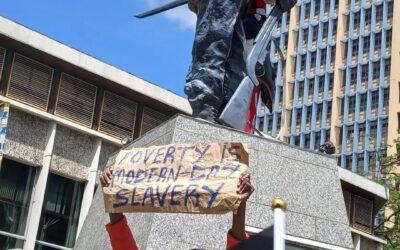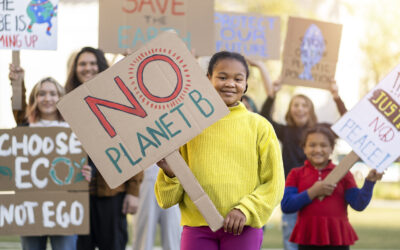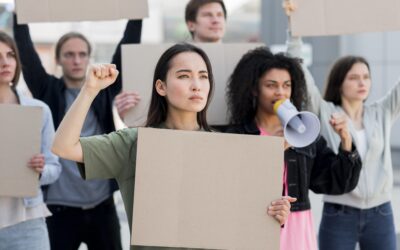As the safety of girls in society remains a major concern due to social ills such as child trafficking, the education gap further widens (Currently, 129 million girls out of school currently according to UNESCO).
According to the United Nations, child trafficking has three major elements which include the act, the means and the purpose. The purpose is mostly linked to sexual exploitation, forced labour and slavery – all which rob children, most of them young girls, of their future and their education. According to Save the Children (2021), even though both boys and girls have fallen victim to child trafficking, girls are the ones who are disproportionately targeted, leading to increased gender inequality in terms of education. Research shows that girls are twice as likely to be trafficked in comparison to boys, which translates to 120 million girls worldwide being trafficked at least at a point in their lives (ibid).
Photo Credit: UNICEF
In the case of developing countries, the situation stays the same. For example, in Daulatdia in India where one of the largest brothels in the world is located, the case of trafficking young girls between the ages of 10 and 18 is prevalent (Save the Children, 2021). Shuma in Daulatdia, who is the daughter and granddaughter of a sex worker, is another case of a girl stuck in the cycle of sex trafficking. However, she has other dreams – dreams of being an English teacher, and so she wants to get an education and avoid the fate of her predecessors. In her own words, “Girls should be able to study and fulfill their dreams, they should decide for themselves what they want to be. If I study, I will do well in life.” (ibid). Though this seems like a wish, thanks to the efforts of Save the Children, Shuma will be more empowered to fulfill her dream of becoming an English teacher. Save the Children works to provide safe spaces for young girls to study and simply ‘become children again’. However, safety for girls will only become a reality when government institutions ensure that measures put in place by charities such as Save the Children are not just a temporary fix, and make addressing gender based violence a priority in their policies and interventions.
In the case of countries in Sub Saharan African countries such as Ghana, Benin, Nigeria and Togo, outmoded cultural practices such as the Trokosi (slave of God) system further widen the gender inequality gap and deprive young girls of getting an education. According to Msuya (2017), this system entails young virgin girls as young as 6 years who end up becoming slaves to Gods in the shrines, and are used as an atonement for sins committed by their families. They labour, provide sex and can be beaten if they intend to escape as some of them are meant to serve the gods for the rest of their lives. Despite the efforts of the government of Ghana to criminalize Trokosi in 1998, it continues to be practiced widely due to the fear placed in families by tradition (ibid).
Several studies have shown the damage the Trokosi system does to young girls and their education amidst the battle to end it. A study conducted by ING (International Needs Group), an Anti-Trokosi campaign movement since 1998, spells out the socio-economic effects of these young girls and especially their inability to pursue an education even if they wanted to (Mensah, 2018). Mercy, who is an ex Trokosi, has missed out on education because of her confinement to the shrine since the tender age of 8 after her parents condemned her to a Trokosi camp to atone for the sins of her aunt (Bastine, 2010). But she is not the only one – generations before her have suffered similar fates in her family. Ultimately, although the Criminal Code (Amendment) Act, 1998 of Ghana outlaws Trokosi practices,his practice still exists in certain parts in Ghana and Sub Saharan Africa, continually disrupting the safety and education of these girls.
Closely linked to child trafficking is the issue of child soldiers. A child soldier or a child associated with an armed force group, according to the Paris Principles in 2007, is any person, 18 years of age or younger, who is or has been recruited or used by an armed group in any capacity (UNICEF, 2007). These children normally act as slaves, sex workers, cooks, messengers among others. Child Soldiers International (2019) asserts that the number of children involved in armed conflicts has risen 159% since 2012, with almost 30,000 verified cases of recruitment in 17 countries around the globe. Former child soldiers who had been rescued reported having to commit horrific acts, such as killing their own parents, as a form of initiation and showing allegiance; others have reported having to participate in killing war captives, or hurting other child soldiers (Klasen, Reissmann, Voss, & Okello, 2015). Child soldiers who survive war are left traumatized, vulnerable to re-recruitment, and sometimes re-victimized by being detained and punished for involvement in war crimes (Klasen, et al., 2015; United Nations, 2018).
Worth mentioning is the case of Kony in 2012 who robbed many children in Uganda of their future of having an education by turning them into child soldiers. Apart from Uganda, other African countries noted to have been using child soldiers include Central African Republic, Chad, Democratic Republic of Congo (US Department of State, 2013). It is also worth noting that being recruited as child soldiers is normally influenced by lack of access to education – but being recruited does not stop the children’s dream for a better future. In Liberia, 77 percent of former child soldiers said they wanted to return to school (ibid). However, ongoing lack of access to formal education presents special challenges for the reintegration of child soldiers into society.
Furthermore, girls make up an estimated 10 to 30 percent of child soldiers used for fighting and other purposes (United Nations, 2018). They are especially vulnerable when it comes to sexual violence. It is therefore important that girls are centred in the conversation to tackle children being recruited to war.ccelerated formal and informal education programmes are among the solutions to help girls avoid sexual violence and to ensure the further closure of the educational gender inequality gap.
In conclusion, the issue of child trafficking in developing countries threatens the future of young girls, their education and their overall socio-economic contribution to their countries and the world. It is essential that governments show much more concern than they currently are, by providing suitable measures in eliminating child traffickingt.It is important to remind ourselves that the , the effects of child trafficking have devastating effects not only on the individual but on the society as a whole, making it essential to act now or risk an unsafe environment for the future generation to pursue their educational goal.
References
Bastine, N. (2010). The Relevance of National and International Laws for the Protection of the Rights of Women and Children in Ghana: A Critical Look at the Trokosi System in Ghana.
Research Gate. Ontario International Development Agency. ISSN 1923-6662 (online)
Child Soldiers International. (2019). Child soldier levels doubled since 2012 and girls’ exploitation is rising. Retrieved from: https://www.child-soldiers.org/news/child-soldier-levels-have-doubled-since-2012-and-girls-exploitation-is-rising
Klasen, F., Reissmann, S., Voss, C., & Okello, J. (2015). The guiltless guilty: Trauma-related guilt and psychopathology in former Ugandan child soldiers. Child Psychiatry & Human Development, 46(2), 180–193. https://doi-org.proxy.lib.ohio-state.edu/10.1007/s10578-014-0470-6
Mensah, W. (2018). Girls in West Africa offered into sexual slavery as ‘wives of gods’. The Conversation. Available from: https://theconversation.com/girls-in-west-africa-offered-into-sexual-slavery-as-wives-of-gods-10 5400. Dare Accessed: 14th July 2021.
Msuya, N. H. (2017). Tradition and Culture in Africa: Practices that Facilitate Trafficking of Women and Children. Dignity: A Journal on Sexual Exploitation and Violence, 2(1), 13– 15. https://doi.org/10.23860/dignity.2017.02.01.03
Save the Children (2021). The Fight Against Child Trafficking. Available from: https://www.savethechildren.org/us/charity-stories/child-trafficking-awareness Date Accessed: 14th July 2021.
The World Bank Group (2021). Girls’ Education. Available from: https://www.worldbank.org/en/topic/girlseducation#2 Date Accessed: 14th July 2021.
United Nations International Children’s Emergency Fund (UNICEF). (2007). The Paris Principles: Principles and Guidelines on Children Associated with Armed Forces or Armed Groups. Retrieved from: https://www.unicef.org/emerg/files/ParisPrinciples310107English.pdf
United Nations. (2018). Children in Armed Conflict: Report of the Secretary-General. General Assembly Security Council. Retrieved from https://www.un.org/ga/search/view_doc.asp?symbol=S/2018/465&Lang=E&Area=UND



